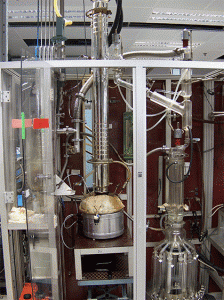https://www.youtube.com/watch?v=gYnGgre83CI
The three distillation methods of interest include true boiling point distillation, ASTM distillation, and equilibrium flash vaporization. Each process can be called upon depending on the level separation precision necessary for a specific use. Perhaps, the most important method is simulated distillation, which has increasingly beneficial implications as opposed to physical distillation (i.e. true boiling point distillation). Nonetheless, compared to the other three refinery processes (conversion, finishing, and support), separation requires the most energy, so the method choice must maximize the use of energy for precision.
 Figure 1: Repsol (Source)
Figure 1: Repsol (Source)
True boiling point distillation (TBPD) is used to characterize the incoming crude oil. It is important to have an approximated crude assay to properly prepare the refinery controls. An unexpected high pressure in the distillation column could be catastrophic economically and environmentally. Precision is of the utmost importance in this distillation, and since this process is used for the crude oil and not preprocessed petroleum products.
ASTM distillation are more useful than true boiling point distillation for petroleum products although the mechanisms for separation are similar (batch process). Unlike TBPD, ASTM distillation does not utilize a condenser-receiver system for refluxing as described in the YouTube video, nor does it require the materials for the TBPD plates. While this may lead to more overlap in crude oil separation, this level of separation precision is acceptable for petroleum products with less probability of overlap.
Equilibrium flash vaporization is utilized in at the extreme ends of the distillation column. The re-heater at the bottom of the atmospheric distillation column is used in an EFV process. This provides the least effective separation of the three.
Unfortunately, I am a bit surprised that no Google patent searches could display findings of renewable energy integration in this energy intensive process. I would imagine that concentrated solar energy may not be relied on as a baseline power source for the pre-heating and re-heating processes. However, I could imagine that on a normal Louisiana summer day, this could be reasonably beneficial. If anyone has any information that I have failed to come across, please let me know!
Reference:
http://chemeng-processing.blogspot.com/2009/01/refinery-distillation.html

